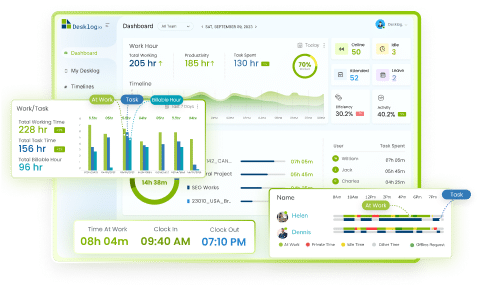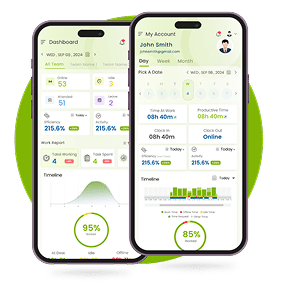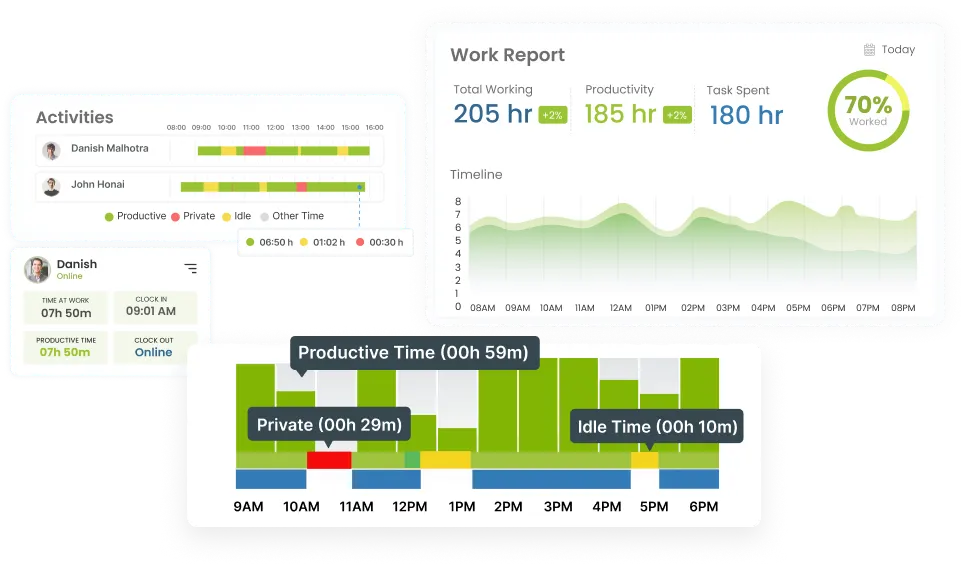Deploying time tracking in enterprises is notoriously difficult. Most IT firms either:
Stick with manual logs that are inefficient, error-prone, and impossible to scale.
Or adopt surveillance-heavy trackers that damage culture and increase attrition.
Many large IT firms face the same challenge; budgets overrun, manual logs fail, and heavy trackers hurt trust.
This case study shows how one IT firm used Desklog to cut project overruns by 20%, stop revenue leakage, and build trust, through automated, privacy-first tracking without invasive monitoring.
Preview In the sections below, you’ll see:
- The hidden costs of manual tracking and low morale
- Financial Risks of Poor Tracking in Large IT Firms
- Why Desklog became the only viable option
- Change Management in Large Enterprises: Lessons from the Rollout
- How 600 employees embraced change without friction
- The Conclusion: Desklog’s Role in Future-Ready IT Operations
The Hidden Costs Of Manual Tracking And Low Morale
Pre-Desklog Challenges: Rising Costs & Productivity Gaps
Before adopting Desklog, the IT firm faced mounting inefficiencies. Rising costs, declining morale, and lack of visibility created barriers to smooth project execution and profitability.
1. Budget Overruns from Inefficient Tracking
For a company of this size, spreadsheets and manual logs were unsustainable. Around 15 -20% of project budgets evaporated due to inconsistent entries, with hundreds of billable and non-billable hours slipping through unrecorded. These losses translated into millions annually. On top of that, delayed and error-prone invoices disrupted cash flow across departments. Automation was no longer optional, it became mission-critical.
2. Employee Pushback Against Invasive Tools
The firm had previously tried competitor time-tracking solutions, but the results were damaging. Distributed teams expressed high dissatisfaction, turnover increased due to employee burnout and mistrust, and many employees openly resisted what they labeled “spying tools.” Desklog’s no keystroke logging policy and configurable screenshot options became a turning point, giving leaders oversight while preserving employee privacy.
3. Fragmented Systems Limiting Profit Insights
Project management, time tracking, and finance were handled across three disconnected platforms. This fragmented setup created blind spots in project profitability and delayed recognition of underperforming initiatives. Leaders were forced into reactive decision-making, unable to allocate resources proactively. Desklog’s built-in profit-and-loss calculator finally unified these processes, delivering real-time visibility and control.
4. Lost Productivity at Scale
With 600 employees, even small inefficiencies multiplied into significant productivity gaps. Leaders lacked the ability to see how time was being spent across projects, which resources were overloaded, or where delays originated. This made it nearly impossible to maintain accountability at scale.
5. Lack of Standardization Across Teams
Different teams used different tools and reporting methods, creating inconsistencies in time tracking and project reporting. Without a single standardized system, data quality suffered and cross-department collaboration weakened.
6. Limited Strategic Control
The absence of integrated insights prevented leadership from aligning resources with strategic priorities. Decisions were made reactively, often too late to prevent revenue leakage or missed client deadlines. The inability to see the “bigger picture” left the firm vulnerable to recurring inefficiencies.
Financial Risks of Poor Tracking in Large IT Firms
When IT firms scale past a few hundred employees, the risks of relying on manual logs or fragmented tracking systems multiply. The financial impact often stays hidden until it surfaces as missed revenue or budget overruns. Here’s a closer look at the money side of poor tracking:
Revenue Leakage
Every missed or under-recorded billable hour chips away at margins. Over time, these small leaks can amount to millions in unbilled work, especially in client-heavy environments where accuracy defines profitability.
Delayed Cash Flow
Invoicing errors or disputes slow down collections, creating bottlenecks in cash flow. Without transparent proof of work, clients push back on invoices, and firms are left juggling outstanding receivables.
Reactive Budgeting
Without real-time cost visibility, leadership is forced into reactive decision-making. Budgets are adjusted only after problems escalate, leaving little room for proactive financial control.
Low Utilization Rates
Resources get tied up in the wrong projects because there’s no reliable utilization data. High-value talent may be underused while low-priority work consumes significant hours. This imbalance reduces efficiency and inflates overhead.
Project Cost Overrun
Perhaps the most damaging risk; when hours, expenses, and deliverables aren’t tracked against contracts in real time, projects run beyond their allocated budgets. Project cost overruns erode client trust, reduce profit margins, and can even result in penalties or lost renewals.
This is why firms that adopted Desklog saw a step change in financial control. With integrated P&L views, real-time utilization analytics, and automated billing, leaders gained a single source of truth. Instead of chasing after missing hours or disputed invoices, Desklog ensured accurate records, faster cash cycles, and sustainable profitability at scale.
Why Did Desklog Become The Only Viable Option?
For a 600-person IT firm, selecting the right time-tracking solution meant balancing scalability, automation, financial visibility, and employee trust. When benchmarked against competitors, Desklog distinguished itself by offering privacy-first monitoring, cost-effective deployment, and enterprise-ready features.
1Automation and Scalability Across 600+ Employees
Managing hundreds of employees required automation at scale. Desklog eliminated manual entries with automated time tracking, accurately capturing work hours while distinguishing active, idle, and private time. It also produced automated timesheets in real time, saving hours of manual compilation and reducing errors. Managers gained access to smart productivity reports, while employees could review their own usage, ensuring transparency. Combined with automated app/URL tracking, the firm could surface trends without adding administrative burden.
2Built-In Billing & P&L Integration
Beyond time tracking, Desklog proved invaluable in financial management. With project time tracking at its core, the system ensured every billable hour was accurately captured and linked directly to project billing and invoices. This supported flexible models such as flat-rate, task-based, or user-specific hourly billing. By generating invoices automatically, it reduced disputes and strengthened client confidence. Additionally, Desklog’s profit and loss calculator gave leadership visibility into revenues and expenses per project, allowing them to identify underperforming accounts early and reallocate resources proactively.
3Simplifying Workforce Management
Desklog also addressed HR challenges by providing attendance management. Employees gained self-service options for leave requests, while managers could view workforce availability and schedule shifts in real time. This simplified workforce planning, reduced administrative bottlenecks, and ensured the right resources were available at the right time. By combining attendance tracking with shift scheduling, Desklog supported healthier work-life balance across teams, an important cultural shift compared to “spying tool” alternatives.
Change Management in Large Enterprises: Lessons from the Rollout
Rolling out new systems in a large enterprise is never just about technology, it’s about people. The success of this IT firm’s Desklog adoption came from how leadership managed the transition with empathy and structure.
Clear Leadership Communication
Executives framed the shift not as surveillance, but as a smarter way to remove manual work and ensure fair recognition of effort. This narrative helped build trust from the start.
Pilot Testing with Smaller Teams
Instead of forcing a company-wide change, the rollout began with a few departments. Their positive results created internal proof points and advocates who encouraged wider adoption.
Training Workshops with a Focus on Benefits
Rather than just explaining “how” to use Desklog, workshops emphasized “why”; faster billing, fewer disputes, and recognition of actual contribution. Employees understood the direct impact on their daily work.
Open Forums for Concerns
Town halls and Q&A sessions gave employees a space to raise worries about privacy or workload. Leaders addressed them openly, showing that the system was designed to protect, not punish.
The result was a smoother adoption curve with lower resistance. By managing change as a human process, not just a software rollout, the enterprise ensured Desklog became a tool employees embraced rather than resisted.
By managing change as a human process, not just a software rollout, the enterprise ensured Desklog became a tool employees embraced rather than resisted.
Key Takeaways & Lessons Learned
Implementing Desklog taught the IT firm that ethical, privacy-first tracking and integrated tools increases productivity and brings employee satisfaction. The lessons highlight how thoughtful technology adoption can deliver measurable financial and cultural benefits.
Ethical Tracking Delivers Better Outcomes
Privacy-first monitoring builds trust, increases adoption, and strengthens employee engagement, especially in large organizations. Employees feel respected and more motivated when tools are transparent. Ethical tracking reduces fear of surveillance, lowers stress, and encourages self-improvement.
Integrated Tools Enable Holistic Management
Combining time tracking, billing, and profit analysis provided a single source of truth for decision-makers across departments. Unified data helped leaders spot inefficiencies, prioritize high-impact projects, and reduce redundancies across teams.
Success Goes Beyond Numbers
Employee satisfaction and retention mattered as much as project savings. Leaders measured both financial metrics and well-being outcomes to achieve sustainable results. Recognizing individual and team contributions reinforced positive culture and fostered loyalty.
Phased Implementation Reduces Resistance
Rolling out Desklog gradually with pilot groups, training workshops, and voluntary adoption minimized disruption and improved acceptance across teams. Early feedback loops allowed adjustments to workflows and settings, creating a smoother company-wide transition.
Data-Driven Decision Making
Real-time visibility into productivity, project progress, and profitability allowed managers to make proactive adjustments and optimize resource allocation. Trends and patterns surfaced by Desklog guided better forecasting, helped anticipate bottlenecks, and informed strategic planning.
Scalability and Flexibility Matter
Tools that scale with team growth and adapt to hybrid work environments ensure consistent oversight without compromising employee autonomy or privacy. Desklog’s offline tracking and cross-platform compatibility enabled increased employee performance monitoring across offices, remote workers, and distributed teams.
Enhanced Employee Empowerment
Employees could self-review their productivity, track billable hours, and manage time efficiently. This sense of ownership improved accountability and encouraged continuous improvement.
Proactive Financial Control
Integrated P&L and billing automation gave leadership foresight into revenue leakage and project margins. Managers could take corrective action early, ensuring projects stayed profitable and reducing dependency on end-of-quarter reconciliations.
Sustainable Organizational Growth
By balancing privacy, automation, and insight, Desklog helped the firm scale efficiently while maintaining high morale. The company now had a framework for long-term productivity improvements and a healthier work-life balance culture.
The Conclusion: Desklog’s Role in Future-Ready IT Operations
Privacy-first, automated systems are shaping the next era of enterprise productivity. By combining time tracking with integrated finance tools, Desklog eliminates the need for multiple fragmented platforms, creating a unified workflow and clearer decision-making.
Organizations using Desklog are better equipped for AI-driven analytics, efficient hybrid workforce management, and scalable operations, while maintaining a culture of trust and transparency. With accurate, automated insights, enterprises can grow confidently without compromising employee engagement or operational efficiency.
FAQs
1How does Desklog handle enterprise-scale time tracking?
Desklog is built to scale easily, whether for hundreds or thousands of users. It avoids invasive practices like keystroke logging, instead using privacy-first monitoring that captures accurate project time data. This helps enterprises maintain trust, reduce burnout, and improve team productivity without compromising employee morale.
2Can Desklog integrate with existing enterprise project management tools?
3What ROI can large IT firms expect from Desklog?
Enterprises typically see cost savings through more accurate billing, recovery of untracked hours, and improved project efficiency. With integrated profit and loss reporting, leadership can identify underperforming projects early, optimize resource allocation, and drive measurable ROI without hidden costs.
4Is Desklog suitable for hybrid and remote enterprise teams?
Absolutely. Desklog includes features like offline time tracking, app/URL monitoring, shift scheduling, and configurable reports. These tools keep distributed teams aligned while giving managers clarity on progress. Employees retain autonomy, creating a balance between accountability and trust in hybrid or remote environments.
5How quickly can large teams see measurable results?
Adoption is rapid, and results can often be seen within weeks. Improved billing accuracy, better resource utilization, and clearer profitability insights emerge early on, with long-term benefits in efficiency and cost savings becoming more pronounced over time.

















